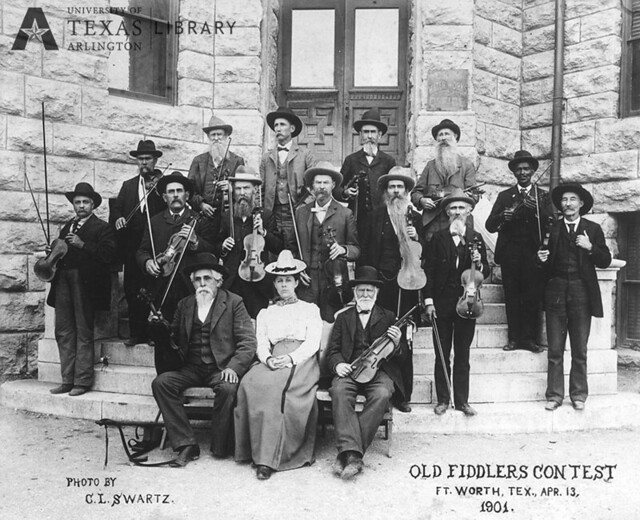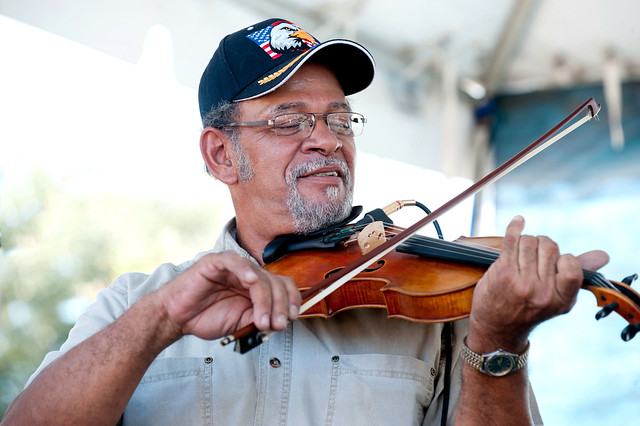Yes, not "Texas Fiddle" but "Texas Fiddling." Doesn't seem much more than semantics, but there is a real change in the wind afoot and from my perspective that's a very good thing.
 |
| I see folks other than Anglo-Texan here, do you? |
The term "Texas Fiddle" has for far too long been restricted to the very narrowest band of the contemporary "contest" culture of Anglo-Texan music. To be clear here, we're talking about music played primarily to impress a judge at a contest, so as to win a cash prize. It may have started out as something quite different, but like so many American institutions, the people who started it would be hard pressed to recognize, much less enjoy, what it has become.
In my youth, not THAT long ago, the Fiddle Contest was held at the Country Fair where there would be prizes for champion Hog Breeding, Best Apple Pie and a display of Steam Engines and Tractors. There'd be a dance band, sometimes a polka band if it was held in a Bohemian or Moravian populated county. And coincidentally, there was a Fiddle Contest; all in good fun, with age slots for everyone from the rank beginner to actual Pros.
But things changed, gradually at first but now quite completely. The "hey let's get all the neighbors together for some family fun" element has receded, replaced with atmosphere of oft-acrimonious combat, where the weak were vanquished and humiliated in public by decidedly un-neighborly out-of-towners who made a side business of snatching prize purses wherever they could. As the context changed, so too did the music. In many way it became the perfect "kudzu" of fiddling style, and testosterone boosted version of Scots-Irish traditional tunes that appealed to
the listener and in many ways washed over and drowned all the many regional styles of fiddling around the whole US, much less here in Texas. It was, and is, a "white" washing of Texas culture.
But there's always been so much more to the story and it has been one of the great joys of my life to seek out and promote these other "flavors" of Texas fiddle music. This festival marks what I hope is a sea-change in how the public see "Texas" fiddling, in all it's many shades, ethnicities and communities.
(I will relate however that this festival feels really familiar. I guess maybe its because I've been actively working with, in some cases actually discovering, 80% of the participants at this event. I guess it really is true that a "prophet has no honor in his hometown;" in my 25 years in Texas hardly any of these folks got any attention at home, but I leave for good and this happens. Not sure how to feel about that, other than to be validated in my contention that these voices are worth listening to all along. Dad always said: "Pass on the credit, but take the cash!")

I first encountered border fiderelo Jose Moreno, at a Panchanga in San Benito TX while on tour with Santiago Jimenz, Jr. and Don Walser 1995. Eventually and with much prodding got Arhoolie to cut a CD with him, which lead to an invitation teaching staff of the The Festival of American Fiddle Tunes in Pt. Townsend, (and there was that time at the Blackpot Festival his drummer didn't show up and was my first and last time as a conjunto drummer!!) His music is a genuine mixture of Native American "matachine" music, Orquestra Tipica and even classic border Tex-Mex. He's a fine accordionist and mandolinist as well and not to be missed.
 |
A very proud Polish Papa
|
Union Organizer/Independent Radio DJ Frank Motley introduced me to Brian Marshall's community of familial music making over 20 years ago and in that time we've been up in Pt. Townsend twice and have appeared on many stages around the US including the Lincoln Center for the Arts, Lowell Folk Festival and the American Folk Festival on the Bangor Waterfront. We've been playing music log enough for Brian to raise up a whole second generation of Marshall Musicians, Jakub and Mika, clarinet and fiddle respectively.
 |
| Mr. Poullard |
And it was through Brian I met the amazing Ed Poullard, equally deft on fiddle or one of his very sought after hand built accordions, and his Creole community as well. Ed's one of the nicest people I have ever met and his smile shines through in his fiddle playing especially.
Though he will have his "Celtic" fiddler hat pull on tight at this event Sean Orr, one of the longest collaborators I have in the music business, and I just released a CD of our collective Texas/Oklahoma traditions called "Texas Fiddle - Okie Guitar."
KITHFOLK said "Texas fiddler Sean Orr and Texas-based, Okie guitarist Mark Rubin say there's no "right" way to play Texas fiddle, but they're wrong. THIS is the right way to play Texas fiddle. Full of heart, brimming over with camaraderie, rough-hewn and rowdy, dusty as hell, and beholden to no man. There's a freedom in this music and a powerful sense of love. All the things that make Texas great."
I'll let Howard Rains tell you himself how he came to his calling.
I will say it involved my apartment, his artwork, a really nice Tonk Bros. Guitar, a few glasses of Portuguese Absenthe and quite a bit of yelling and screaming. It did however lead to a controversy involving the New York Times and a series of delusional and public tirades by a very well known one-time Contest winning violinist. Really, its a great story. Ask him when you see him. Seriously.
These are just the guys I've been working with for many year however and there are plenty of mighty fine fiddlers to be heard there as well. Follow this link for more info.
In Yiddish we call the feeling I have about this event as "kvelling."
Please thing about coming out and seeing what all the hub bub is about!





























